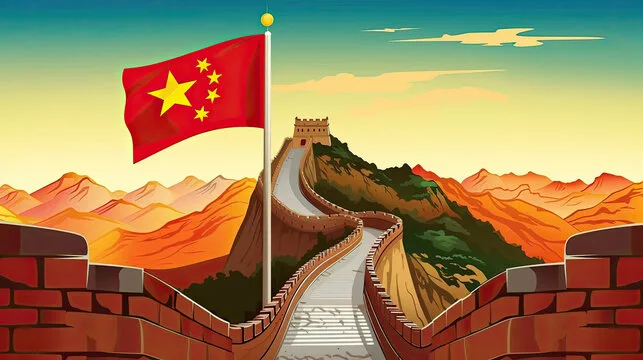China, one of the world’s most populous and expansive countries, boasts over 1.4 billion people. It borders fourteen countries and spans the equivalent of five time zones. With a GDP of $17.73 trillion, China is known for its industriousness. However, beyond the statistics, China is a land of fascinating, unique, and beautiful sights. Here’s a look at some of the most intriguing attractions that might inspire you to visit.

1. The World’s Largest Buddha Statue
The Leshan Giant Buddha, a towering 71-meter-high statue, is a must-see in Sichuan Province. Constructed during the Tang Dynasty (618–907 AD), it honors Maitreya Bodhisattva and took over ninety years to complete. This majestic statue, seated on a lotus throne, is one-sixth the height of Philadelphia’s Comcast skyscraper.
2. The Green Village
Houtouwan, known as the Green Village, is an abandoned fishing hub on Shengshan Island, now overtaken by nature. Once home to over 2,000 fishermen, it was deserted in the 1990s due to logistical challenges. Today, lush greenery blankets the village, creating a hauntingly beautiful scene.

3. Dragon Escalator
Longqing Gorge, home to one of China’s largest dams, features the world’s largest outdoor escalator. This bright yellow dragon-shaped escalator transports visitors from the gorge’s base to its summit, where activities like cable car rides, boat trips, and bungee jumping await.
4. Ducks on Leashes
Pet ducks, a niche yet popular trend among Chinese millennials, can fetch prices as high as $2,759. These domesticated ducks, often walked on leashes, became a sensation. In 2023, Shanghai police rescued a stolen pet duck worth $725 just before it was to be cooked, returning it to its distraught young owner.

5. Spicy Hotpot
Sichuan hotpot, a fiery and boiling delicacy, is a staple for spice lovers. Originating from Sichuan, this dish includes seafood, meat, offal, vegetables, noodles, and Sichuan peppercorns, offering an intense culinary experience.
6. The Giant Rubber Duck
In 2013, Hong Kong hosted the famous six-story-tall rubber duck art installation. Although it deflated on May 15th, it was reinflated and restored on May 20th, continuing to charm visitors.
7. The Face-Kini
Zhang Shifan created the face-kini to protect beachgoers from UV rays, insects, and jellyfish. These face masks, made from swimsuit material, cost between $2 and $24, with newer models covering the entire body.
8. Fake Brands
China’s efficient labor force and high production rates have made it a hub for counterfeit goods. According to the OECD, China produces three-quarters of the world’s fake brands, prompting buyers to double-check their purchases to avoid knockoffs.
9. Chili Pepper Eating Contest
Hunan Province hosts an annual spicy chili pepper eating contest in July, drawing fierce competitors. In a recent contest, Tang Shuaihui ate fifty chili peppers in just over a minute, showcasing his extraordinary tolerance for spice.

10. Packed Resorts
China’s popular No. 1 Bathing Beach in Qingdao attracts massive crowds, making it unsuitable for those who dislike crowded places. The sheer number of beachgoers can be overwhelming for visitors unaccustomed to such density.
11. Carrying Fish in Your Clavicles
The “Fish in Collarbone Challenge” was a mid-2010s trend where girls showcased their thinness by fitting fish into their clavicles. Although now outdated, it highlights the evolving standards of beauty and body positivity.
12. The Forbidden City in Beijing
Beijing’s Forbidden City, once the exclusive realm of the imperial household, now welcomes all visitors. Spanning 180 acres with 9,000 rooms, this historical marvel offers a glimpse into China’s rich past.

13. The World’s Most Dangerous Hike: Huashan Mountain
Huashan Mountain, with its steep cliffs and breathtaking views, is renowned for its treacherous hiking paths. The mountain also features ancient temples like the Tang Dynasty’s Temple of the Five Immortals.
14. Giant Panda Breeding Center
The Chengdu Research Base is dedicated to the conservation of Giant Pandas. Home to over 100 pandas, the center’s efforts have been crucial in slowly increasing the population of this vulnerable species.
15. Imaginative Barbers
Chinese barbers are known for their creative designs, often etching intricate patterns into clients’ hair. Unique techniques, such as using hot iron bars for haircuts, highlight the barbers’ ingenuity and skill.
16. Team Exercising at the Park
Outdoor group workouts are a common sight in China’s parks, particularly among the elderly. These morning rituals promote health and community, reflecting the government’s push for active lifestyles.
17. Century Eggs
Century Eggs, a preserved delicacy from Hunan, involve curing quail, chicken, or duck eggs in a mixture of rice hulls, quicklime, salt, ash, and clay. Despite their name, these eggs are preserved for weeks or months, costing around $1 to $2 each.
18. Carrying a Hot Water Bottle
In China, carrying hot water bottles is a widespread practice, especially in rural areas. This tradition dates back to ancient times when hot water was a luxury.
19. Major Ghost Cities
China has around fifty empty megacities, with Kangbashi being one of the most famous. These ghost cities, often uninhabited due to financial reasons, attract dark tourists and spark debates on their future potential.
20. The Great Wall of China
Spanning 13,000 miles, the Great Wall of China is an engineering marvel built over centuries to protect Chinese territories. Today, it draws millions of visitors eager to experience its grandeur firsthand.

21. Police Geese
In 2022, Chinese police used geese instead of dogs for extra security, relying on the birds’ natural territorial instincts to enforce curfew rules during the pandemic.
22. Over-The-Top Manicures
China, credited with creating the first nail polish, continues to lead in extravagant nail designs. Modern Chinese nail artists create intricate, embellished designs that showcase their exceptional skills.
23. A Watermelon Museum
The China Watermelon Museum in Beijing, built in 2002, celebrates the region’s status as a top watermelon producer. The museum features exhibits on the fruit’s history, varieties, and cultural significance.
24. Exotic Street Food
China’s street food scene offers a variety of unusual delicacies, from scorpions on sticks to spicy rabbit heads. These affordable treats range from $1 to $6 and provide a unique culinary adventure.
25. Extreme Traffic
China’s high population contributes to severe traffic jams, with the 2010 National Highway 110 jam being the worst in history. Spanning over sixty miles, it lasted a week and a half, with some drivers stuck for five days.

26. Crowded Water Parks
Photos of China’s packed water parks during a 2022 heat wave went viral, highlighting the extreme crowds that are typical in the country’s recreational areas.
27. Full-Time Mask Wearing
Even before the 2020 pandemic, mask-wearing was common in China due to pollution concerns. In major cities, wearing masks remains a common practice to protect against air quality issues.
28. The Hanging Temple
The Hanging Temple near Mount Heng in Hunyuan County is a stunning cliff-side structure. Built around 491 AD by Liao Ran and local monks, it serves Taoists, Buddhists, and Confucianists.

29. 798 Art District
Beijing’s 798 Art District, a former military factory complex, now hosts contemporary art, sculptures, boutiques, and cafes. It showcases works by both established and emerging Chinese artists.
30. Teabucks
Teabucks in Shenzhen mimics Starbucks’ branding but focuses on tea. Despite its similar appearance, it highlights China’s penchant for creating imitations of popular Western brands.
31. An Underwater City
Shi Cheng, or Lion City, lies submerged in Qiandao Lake. Flooded intentionally in 1959 to create a reservoir, it now attracts scuba divers and explorers interested in its history.
32. Tianmen Skywalk
The Tianmen Coiling Dragon Skywalk in Hunan offers breathtaking views from a hundred-meter-long glass walkway clinging to Tianmen Mountain. This thrilling attraction opened in 2016 and charges $36 for entry.
33. Incredible Ice Sculpture Festivals
Harbin’s annual Ice and Snow Sculpture Festival transforms the city into a winter wonderland. Massive, illuminated ice sculptures, along with activities like ice skating and skiing, attract millions of visitors.
34. Hong Kong Disneyland
Since opening in 2005, Hong Kong Disneyland has become a major attraction, featuring rides and shows like Space Mountain, Toy Story Land, and The Lion King. It draws families from across Asia.
35. Chinese New Year Celebrations
Chinese New Year, also known as the Spring Festival, is a major celebration marked by feasting, family reunions, and fireworks. Red envelopes filled with money are exchanged, and parades with red lanterns are common.
36. Traditional Chinese Medicine
Traditional Chinese Medicine (TCM) has been practiced for over 2,000 years, offering remedies like herbal treatments, acupuncture, and massage therapies to restore balance in the body.

37. Terracotta Army in Xi’an
Discovered in 1974, the Terracotta Army near Xi’an features thousands of life-sized warriors built to protect Emperor Qin Shi
38. The Painted Pottery of the Yangshao Culture
The Painted Pottery of the Yangshao Culture signifies a major advancement in China’s Neolithic period, dating back to approximately 5000-3000 BC. Discovered in Yangshao village, Henan Province, this culture is celebrated for its distinctive pottery decorated with intricate designs and symbols.
These hand-crafted vessels, featuring geometric patterns, animal motifs, and scenes of hunting and farming, were made without a potter’s wheel. They offer valuable insights into the lives, beliefs, and artistic talents of the Yangshao people. As some of the earliest examples of Chinese artistic expression, these artifacts are priceless links to an ancient civilization that significantly influenced the country’s cultural heritage.
39. The Unique Rock Climbing Experience in Yangshuo
Yangshuo, in Guangxi Zhuang Autonomous Region, is famous for its stunning karst landscape, providing a premier rock climbing experience. With over 300 climbing routes across numerous peaks, Yangshuo caters to both novice climbers and seasoned professionals.
The limestone cliffs, dotted with caves and pockets, offer challenging and varied climbing conditions that attract thrill-seekers worldwide. In addition to climbing, visitors can enjoy hiking, caving, and river rafting, making Yangshuo a hub for outdoor adventure. This promotes eco-tourism and active lifestyles, adding another unique aspect to China’s diverse attractions.
40. The Piano and Violin Building, Huainan
The Piano and Violin Building in Huainan, Anhui Province, is an extraordinary example of modern Chinese architecture. Completed in 2007, this structure features an enormous violin leaning against a grand piano-shaped building.
The transparent violin houses escalators and a staircase, while the piano accommodates city planners and exhibition halls. Illuminated beautifully at night, the building creates a musical spectacle against the city skyline. It’s a popular tourist spot and a favorite among photographers, showcasing China’s creative blend of art and architecture.

41. The Revolving Restaurant in the TV Tower, Shanghai
The Revolving Restaurant in Shanghai’s Oriental Pearl Tower offers a dining experience with panoramic views of the city’s stunning skyline. As the restaurant slowly rotates, guests enjoy a 360-degree view of Shanghai.
This venue symbolizes Shanghai’s modernity and innovation, attracting tourists and locals seeking a memorable dining experience paired with unparalleled views. The revolving restaurant exemplifies China’s ambition to create extraordinary architectural feats that blend functionality and aesthetics.
42. Shadow Puppet Play
Shadow Puppet Play is a traditional Chinese entertainment form, bringing ancient legends, folk tales, and historical narratives to life with intricately crafted puppets made of leather or paper.
The value of watching a Shadow Puppet Play varies based on factors like the performance venue, troupe reputation, and storytelling complexity. It can be a free community event or a ticketed production. This cherished cultural activity connects audiences with China’s traditional performing arts.
43. Guoliang Tunnel Road
The Guoliang Tunnel Road in Henan Province is a remarkable engineering feat carved into a mountain by hand. This narrow, winding road offers breathtaking views and a thrilling driving experience.
Constructed by Guoliang Village residents and the local government to provide access and boost tourism, the tunnel road required years of manual labor with simple tools. It has become a popular tourist attraction, generating revenue through tourism and drawing adventurers seeking an unforgettable experience.

44. Tianzi Mountain Nature Reserve
Located in Zhangjiajie, Hunan Province, the Tianzi Mountain Nature Reserve captivates visitors with its towering sandstone peaks, lush vegetation, and stunning views. Named “son of heaven,” the reserve’s unique rock formations, often shrouded in mist, inspired the “floating mountains” in the movie “Avatar.”
As a UNESCO World Heritage Site, the reserve attracts millions of visitors annually, contributing significantly to the local tourism economy. It offers hiking, bird watching, and immersive nature experiences.
45. Yangshuo County’s Karst Landscape
Yangshuo County in Guangxi Zhuang Autonomous Region is renowned for its mesmerizing karst landscape. The limestone peaks, caves, and scenic rivers create a picturesque environment that has captivated visitors for centuries.
The karst landscape offers breathtaking vistas, inspiring artists, poets, and travelers alike. This natural beauty serves as a testament to the incredible diversity and beauty found in the world.
46. White Horse Temple in Luoyang
The White Horse Temple in Luoyang, Henan Province, is China’s first official Buddhist temple, established over 1,900 years ago. Built by Emperor Ming of the Eastern Han Dynasty, it symbolizes the arrival of Buddhism in China.
The temple’s construction followed the arrival of Buddhist scriptures and a white horse from Central Asia. Representing an invaluable cultural and historical heritage, the temple offers insights into the origins and development of Buddhism in China.
47. The Sino-Korean Friendship Bridge
The Sino-Korean Friendship Bridge connects Dandong, China, with Sinuiju, North Korea, spanning the Yalu River. This bridge is a significant economic and cultural link between the two countries.
Constructed jointly by China and North Korea, the bridge facilitates trade and cultural exchanges, playing a vital role in supporting bilateral relations and promoting diplomatic ties.

48. Hulunbuir’s Vast Grasslands
Hulunbuir’s Vast Grasslands in Inner Mongolia are a stunning expanse of grassy plains with immense ecological and cultural importance. Known for breathtaking scenery, these grasslands are home to diverse plant and animal life, including herds of grazing animals and numerous bird species.
Visitors can experience Mongolian culture, including horseback riding, traditional music, and yurt accommodation, immersing themselves in the natural beauty and cultural richness of the region.
49. The Naadam Festival in Inner Mongolia
The Naadam Festival in Inner Mongolia celebrates Mongolian culture and tradition through thrilling competitions and performances. Featuring wrestling, horse racing, and archery, this vibrant event showcases the region’s rich heritage.
Accompanied by traditional music, dance, and cultural displays, the Naadam Festival offers an immersive experience, attracting participants and spectators worldwide.
50. Shanghai Tower
The Shanghai Tower, located in the Lujiazui Financial District, is one of the world’s tallest buildings, standing at 2,074 feet. Built at a cost of over $2 billion, the tower features an Observation Deck with breathtaking views and elevators traveling at 46 miles per hour.
This iconic skyscraper exemplifies China’s architectural prowess and modernity, making it a must-visit landmark.


